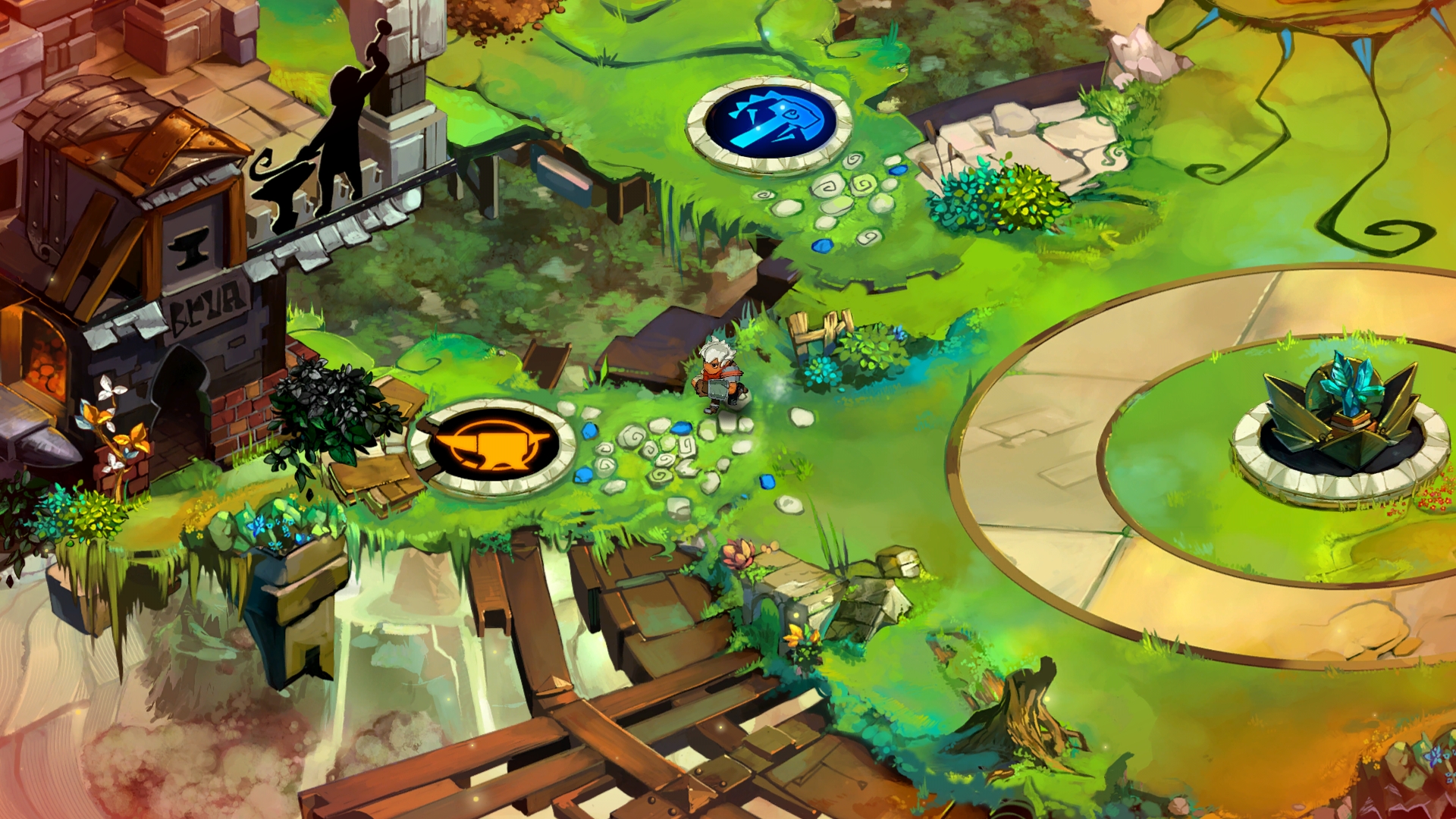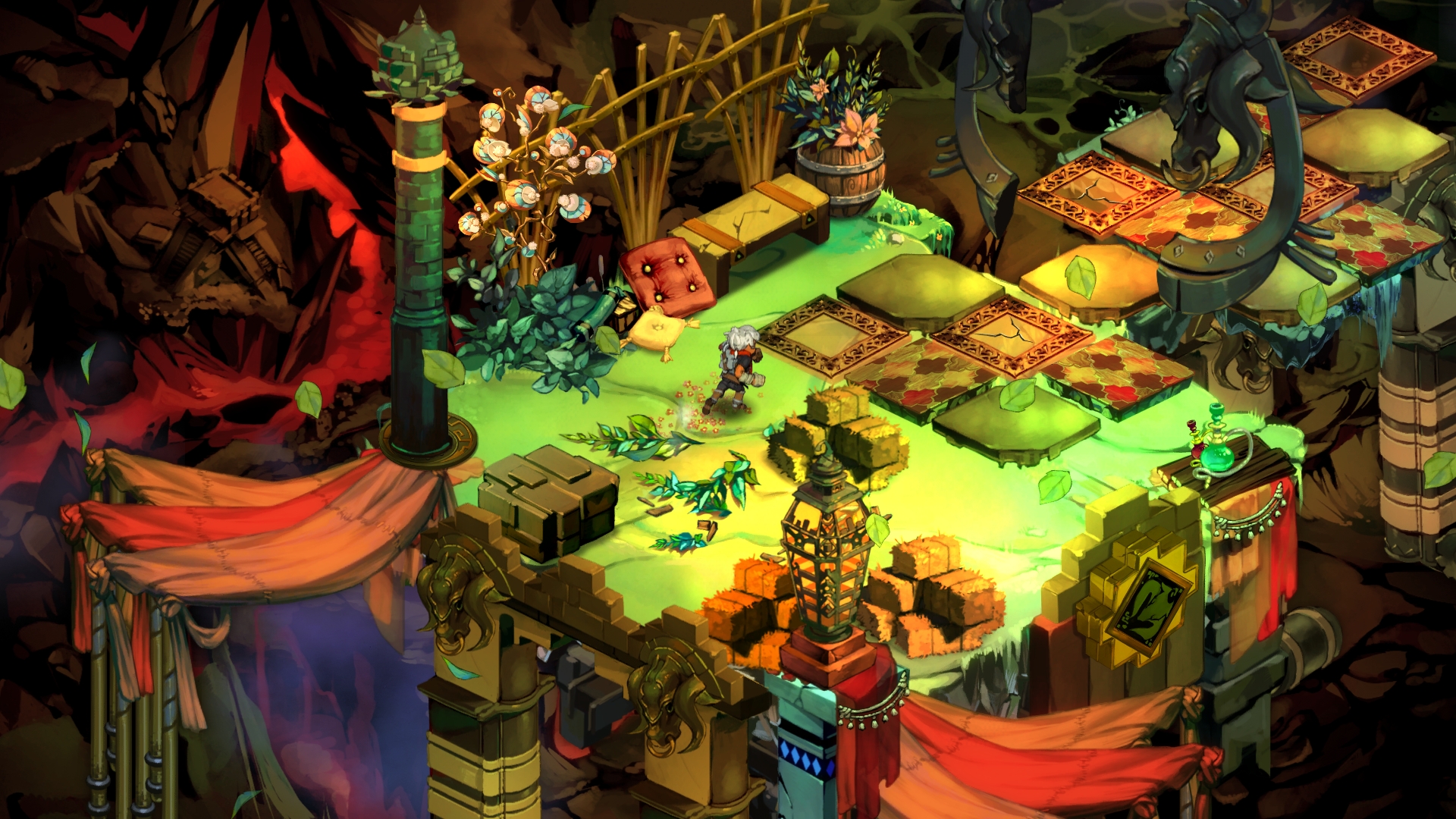Search
[{{{type}}}] {{{reason}}}
{{/data.error.root_cause}}{{{_source.title}}} {{#_source.showPrice}} {{{_source.displayPrice}}} {{/_source.showPrice}}
{{#_source.showLink}} {{/_source.showLink}} {{#_source.showDate}}{{{_source.displayDate}}}
{{/_source.showDate}}{{{_source.description}}}
{{#_source.additionalInfo}}{{#_source.additionalFields}} {{#title}} {{{label}}}: {{{title}}} {{/title}} {{/_source.additionalFields}}
{{/_source.additionalInfo}}- Details
- Category: Computer
- By Sam George
- Hits: 6296
Bastion (PC)

Bastion
Developed by: Supergiant Games
Published by: Warner Bros. Interactive Entertainment
Released: August 16, 2011
Available On: Windows, Linux, macOS, iOS, PlayStation 4, Xbox One
ESRB Rating: E10+ for Animated Blood, Fantasy Violence, and Use of Alcohol and Tobacco
Genre: Isometric Action
Number of Players: 1
Price: $14.99
(Humble Store Link)
The soul of Bastion is the soul of a fairy tale, from the music to the voice acting to the art style. The gameplay driving you through this story of loss, regret, and survival is filled with options and the motivation to explore them. Bastion does not offer the tight mechanical fun of the great platformers or the narrative depth of more cinematic games. Instead, come to Bastion to let your mind explore. The developer, Supergiant Games, describes the effect well in their mission statement: “to make games that spark your imagination like the games you played as a kid”. Sit down, pick up a controller, and let Bastion tell you a story.
The player is dropped into the broken fantasy world of Caelondia with little fanfare. The player character, known only as the Kid, wakes up following an event called the Calamity. His only companions are a hammer and the gravelly voice of the Narrator. The hammer can be switched out later for one of the game’s ten other weapons, but the Narrator’s voice remains. He gives running commentary of the game's events, recounting the actions the player takes as if telling a story by the campfire. The story is minimal, and the Narrator gives you just enough to get connected to the world and wonder what happened to it. Most of the Kid’s time is spent expanding and repairing the Bastion, a safe haven in the midst of the Calamity. He does this by collecting cores of power from the levels spread around Caelondia.
The Narrator has an extensive script, but it is never burdensome. This is thanks to excellent writing and delivery along with Bastion’s unique story mechanic: the reactive script. If you stay in an area, the Narrator has a comment for it. If you blaze through enemies with no trouble, he might comment on that. He says a unique line for each of the fifty-five two-weapon-loadout combinations. The player doesn’t hear character conversations directly; instead, the Narrator describes them. This technique keeps the story moving and provides continuity to the storybook feel of playing Bastion.
Joining the Narrator is a stunning soundtrack. It has a frontier flavor to match the Kid’s exploration of The Wilds. It is creative, unique, and plain good listening. There are a few vocal tracks which especially dominate their respective levels. The soundtrack is available for purchase, and I encourage you to check it out after playing the game.

Strong Points: Beautiful environment and music; well-written, reactive narration; customizable play through buff, debuff, weapon loadout, and weapon upgrade variety
Weak Points: Camera angle makes precise movement and aiming difficult; customization is limited for the first half of the game
Moral Warnings: The player character kills people and animals in a cartoon-styled but seriously-themed world; characters recognize a pantheon of gods
The world of Caelondia has a beautiful, painted style which belies the dark events of the story. The country is quite literally broken, floating in the air as chunks of land. Tiles to walk on rise from below as you approach. Each of the twenty-or-so levels has its own flavor and background. Here’s an old military outpost; there’s the remains of a port town; this mountain has become a center for the few animal survivors of the Calamity. The varied creative animals of Caelondia make up most of the enemies. Different types require different approaches, and levels lend themselves to certain weapons. This ensures that your playstyle is often changed up at the cost of making some weapon combinations virtually unworkable.
The weapons are as varied as the enemies and environments. You always have access to a shield with counter-attack capabilities. There’s the hammer, a bow, a dart launcher, a machete, a spear, several guns, fire-spewing bellows, and more. All can be upgraded with components found in the levels. Each upgrade tier has two options, and you can switch between them anytime you visit the Forge. Upgrades include damage-over-time, homing, armor-piercing, charged shot, and others. Along with two weapons, you can equip a limited-use, rechargeable ability. You can equip stat-boosting elixirs (health, speed, defense, shooting spikes when at low health) alongside debuffs with rewards (increased experience, increased material, etc.). The Kid levels with experience earned by killing enemies, gaining a new buff slot and some HP at each level.
The downside is that you open up many of these gameplay options by rebuilding the Bastion, and that happens over time. After collecting a Core, you choose a single structure to build. If you build the Armory, you won’t have access to the upgrade Forge yet. If you build the buff Distillery, you won’t have the special quest Memorial. You get all the structures before the game’s halfway point, but it can make for some frustrating moments early in the game. This is mitigated somewhat by buildings being accessible within some levels. However, each level becomes inaccessible once you clear it, so this utility is limited.
In step with the increased capabilities of the Bastion are new ways and new reasons to use your fancy toys. Weapons have a challenge stage associated with them. For example, the hammer level requires smashing trash in a dump, and the level built for the pistol, which fires bullets as quickly as you can click, turns the Kid into a dueling sharpshooter. You gain rewards including materials, special abilities, and experience.

Higher is better
(10/10 is perfect)
Game Score - 88%
Gameplay - 17/20
Graphics - 9/10
Sound - 10/10
Stability - 5/5
Controls - 3/5
Morality Score - 86%
Violence - 6/10
Language - 10/10
Sexual Content - 10/10
Occult/Supernatural - 7/10
Cultural/Moral/Ethical - 10/10
It should be noted that these stages and weapons are integrated into Caelondia and the narration without a hitch. This is especially true of the character challenge stages, accessible directly from the Bastion as the story progresses. Each of the few named characters is associated with an item in the Bastion. Interact with it, and you are transported to Who Knows Where, a dreamland where you fight waves of enemies to try weapon loadouts and gain experience. This is also where you learn character backstories. Between waves, the Narrator gives snippets of how these characters got through the Calamity and to the Bastion. The stories are touching, dark, and engaging. Personally, they are what got me to push through the difficult Who Knows Where levels.
Caelondia is a complex world worth exploring without prior knowledge. I’ve avoided worldbuilding and story details to avoid spoilers, but I have to allude to them for the sake of moral analysis. The ethical landscape of Bastion is intentionally murky. You should be aware of a few standard things: buffs come from alcohol at the Distillery, a Who Knows Where stage is entered by smoking a pipe, and your main character progresses by killing animals and people. The screen turns blood red as you lose health. The game is cartoony, but the Narrator makes sure you know the Kid is a tough, violent survivor.
The most interesting aspects of the world come from worldbuilding flavor. The game’s themes are ambiguous and mature. Among them are survivor’s guilt, suicide, war, and revenge. Bastion does not pass judgment on its characters’ actions; it takes the higher ground of letting you form your own opinions. More potentially troubling is the pantheon. The denizens of Bastion recognize, with various levels of reverence, ten gods. Debuffs with rewards are activated at the Shrine dedicated to the various gods, and at least one enemy type is implied to be controlled by a god. You as the player can ignore the Shrine, but you can’t ignore the pantheon. The Narrator says, “Mother only knows,” referring to Micia, the goddess who gives life. He muses on whether or not the gods have abandoned the world. In a song by the Narrator available on the official soundtrack, he says of the gods, “They ain’t gonna catch you when you fall. You’ll be pleadin’ while you’re bleedin’.” Again, the game does not pass judgment on the characters or their beliefs. That’s up to you.
The game has an easy mode to help people get through the story. It also has a score attack mode which allows you to replay levels. It is designed for those who want to focus on the gameplay. Once you finish the main game, you gain New Game+ mode. It lets you carry your unlockables with you into a new playthrough and seems to be the only way to open all buffs and special abilities. The NG+ enemies do not scale in difficulty, potentially resulting in the practiced and well-armed Kid bulldozing through. On the positive side, it is integrated into the story well.
Controls are Bastion’s primary weakness. Paths must be navigated on more than the eight standard directions, and keyboard control takes more effort than it should. The isometric (angled top-down) view does not help matters. Still, the first time I beat the game it was with the keyboard, and it was enjoyable. For NG+ I used a controller. This helped significantly, but it also highlighted deeper problems with movement. The issue isn't the control device per se; the issue is eight-directional movement through a world that requires navigating on more than those eight axes. This isn't uncommon in isometric games, but it is particularly irritating when, as in Bastion, you can fall off the vast majority of the platforms and rolling is your easiest way of escaping heavy enemy fire. There is a mouse-based movement control scheme as well, but I couldn’t get the hang of it. In all modes, the Kid locks onto enemies to help with movement and combat. While this usually helps, there are often so many enemies onscreen that you can’t efficiently switch to the one you want to target. The game gives minor damage for falling off stages and is not punishingly difficult, but the control and camera quirks make challenge areas unnecessarily troublesome. There is fun gameplay here, but the polish went into art and story.
Bastion does all things acceptably and some things exceptionally. The music, art, and voice acting combine to create a beautifully atmospheric game, and the weaknesses of the control scheme do not significantly detract from the experience. The gameplay, while not the highlight, carries its weight using variety in playstyle and enemy design. This game is a work of art. I hope it can “spark your imagination” like it did mine.








